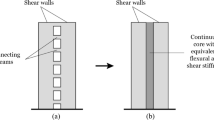Abstract
A standardizing strain gage that meets the requirements for long-time stability of strain measurements is described in this paper. Statistical analyses of the strain calibration results taken over a period of 13 months showed no significant differences between successive calibrations at a 5-percent significance level. From the results of the strain calibrations of 134 gages, the resistance-deformation characteristicdR/dW had a mean of 120.31 ohms/in. with a coefficient of variation of 1.43 percent. Evaluation tests using 6×12 in. concrete cylinders compared the strains measured by the standardizing gage to those measured by the Berry gage. Statistical analyses of these results showed equivalent accuracy of strain measured by the standardizing strain gage at comparable precision.
Similar content being viewed by others
Abbreviations
- D :
-
strain-gage deformation, in.
- d i :
-
difference between the averages of the strains measured by the standardizing and Berry gages
- \(\bar d\) :
-
the mean of thed i strain values of an evaluation test
- dR :
-
change in resistance, ohms
- dW :
-
change in strain-gage length, in.
- F o :
-
computed analysis of variance ratio
- F α, υ1.υ2:
-
tabulated analysis of variance ratio
- G.F. :
-
gage-factor ratio
- L :
-
gage length, in.
- n :
-
statistical sample size or number
- R :
-
resistance, ohms
- S d :
-
standard deviation of thed i strain values of an evaluation test
- t o :
-
computed ratio of the student ort distribution test
- t α,ν :
-
tabulated ratio of the student ort distribution test
- α:
-
percentage of uncertainty of the decision made
- ν:
-
n−1 degrees of freedom oft distribution test
- υ1 and υ2:
-
degrees of freedom in the numerator and denominator, respectively, of the analysis of variance ratio
- σ:
-
standard deviation
References
Berwanger, Carl, “An Evaluation of the Modulus of Concrete and the Coefficient of Expansion of Concrete and Reinforced Concrete at Below Normal Temperatures,” Research Report No. 1. NRC Grant No. A-2709 (May 1967).
Berwanger, Carl, “The Modulus of Concrete and the Coefficient of Expansion of Concrete and Reinforced Concrete at Below Normal Temperatures,” presented at ACI Symposium on the “Effect of Temperature on Concrete,” Memphis, Tenn. (November 5–8, 1968).
Monfore, G. E., “A Standardizing Strain Gage for Measurements Requiring Long-Time Stability,”Bulletin 96, Research and Development Laboratories, Portland Cement Association, Chicago, Ill. (November 1958).
Graves, W. R., “Polynomial Curve Fitting,” IBM Program Library, File Number-7.0.001.
Bowker, A. H., andLieberman, G. J., Engineering Statistics, Prentice-Hall, Inc., Englewood Cliffs, N. J., 175–179 and 315–349 (1959).
Author information
Authors and Affiliations
Rights and permissions
About this article
Cite this article
Berwanger, C. The evaluation of a strain gage having long-time stability characteristics. Experimental Mechanics 9, 401–406 (1969). https://doi.org/10.1007/BF02327005
Issue Date:
DOI: https://doi.org/10.1007/BF02327005




